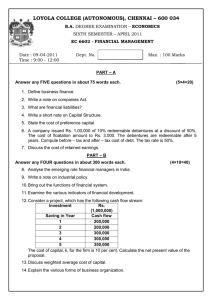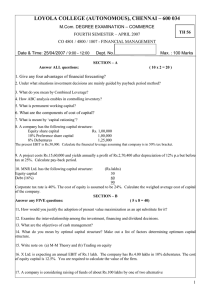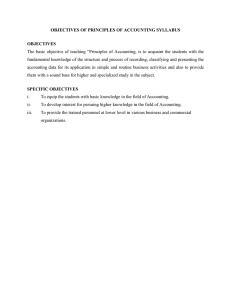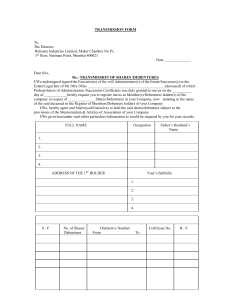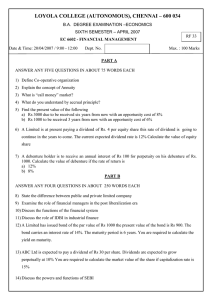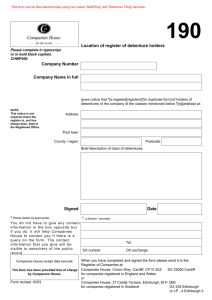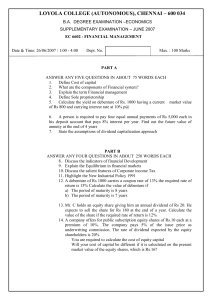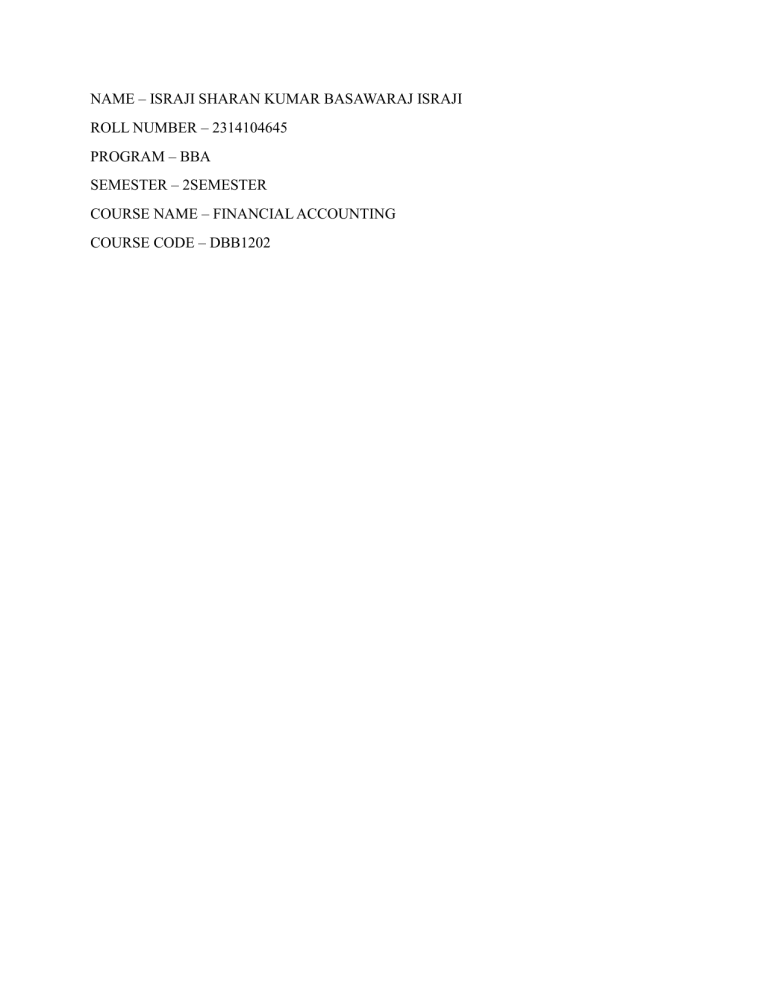
NAME – ISRAJI SHARAN KUMAR BASAWARAJ ISRAJI ROLL NUMBER – 2314104645 PROGRAM – BBA SEMESTER – 2SEMESTER COURSE NAME – FINANCIAL ACCOUNTING COURSE CODE – DBB1202 Assignment set – 1 Answer for Q.No.1) – Q1) The journal entries for the transactions in the books of JL Ltd for the month of January 2023: 1. Started business with cash Rs.1,00,000 Cash (Dr) Rs.1,00,000 Capital (Cr) Rs.1,00,000 2. Sold goods to R Rs.2,000 R (Dr) Rs.2,000 Sales (Cr) Rs.2,000 3. Bought office furniture Rs.30,000 Furniture (Dr) Rs.30,000 Cash (Cr) Rs.30,000 4. Paid cash to M Rs.2,000 M (Dr) Rs.2,000 Cash (Cr) Rs.2,000 5. Salary Paid Rs.10,000 Salary Expense (Dr) Rs.10,000 Cash (Cr) Rs.10,000 6. Rent received Rs.3,000 Cash (Dr) Rs.3,000 Rent Income (Cr) Rs.3,000 7. Purchased goods from H for cash Rs.9,000 Purchases (Dr) Rs.9,000 Cash (Cr) Rs.9,000 8. Goods returned by R Rs.200 Sales Return (Dr) Rs.200 R (Cr) Rs.200 9. Interest on capital paid to owner Rs.800 Interest Expense (Dr) Rs.800 Cash (Cr) Rs.800 10. Returned goods to H Rs.300 H (Dr) Rs.300 Purchases Return (Cr) Rs.300 Answer for Q.No.2) – a) Money Measurement - Concept Each transaction and event must be expressible in monetary terms. The advantages of monetary expression are that (a) it provides a simple measuring device to represent many facts in a common denominator and (b) it is amenable to summarization. If an event cannot be expressed in monetary terms, it cannot be considered for accounting purposes. For example, certain qualitative factors that are vital to the health of a firm may not be accounted such as brand image, business networks, and talent of manpower are not affected in the accounting records. b) Cost Concept - Accounting cost concept states that assets such as land, building, plant and machinery should be recorded in the books of accounts at their purchase price, which includes cost of acquisition, transportation and installation. The cost of the asset is systematically reduced from year to year by charging depreciation on the asset for its usage and wear and tear. The justification for using cost concept is that it can be objectively verifiable. If nothing is paid to acquire an asset, the same will not be recorded as an asset, e.g., a favorable location. The greatest limitation of historical cost concept is that it may create secret reserves when the cost is written off but the asset is still in good condition. Adopting to International Financial Reporting Statement [IFRS] this concept would give way to present value-based accounting. c) Dual Aspect Concept - It is the heart of whole accounting process. It is an expression of entity concept because it shows that the business itself owns the assets and in turn owns the various claimants. This is technically stated as ‘for every debit, there is a credit’. Business firms raise funds in any of the following ways – Additional capital (increase in owners’ equity). Earning revenue (increase in owners’ equity). Profits (increase in owners’ equity). Additional loans (increases outside liability). Disposing of assets (reduces assets) An increase in liabilities (including owners’ equity) and reduction in assets represents sources of funds. These funds can be put to any of the following uses: Purchasing of assets (increase in assets). Cash balances (increase in assets). Operational expenses (decrease in owners’ equity). Clearing liabilities due (decrease in liabilities). Losses (decrease in owners’ equity) All increases in assets and decreases in liabilities (including owners’ equity) represents the uses of funds. The sum of the sources of funds equals the sum of the uses of funds. Thus, the dual aspect of accounting means that “Owner’s Equity + Outside Liability = Assets”. This can be expressed in two other ways. They are – Assets – liabilities = Capital Assets - Capital = Liabilities The above accounting equation states that the assets of a business are always equal to the claims of owner/owners and the outsiders. This claim is also termed as capital or owner’s equity and that of outsiders, as liabilities or creditors’ equity. d) Accrual Concept - Accrual concept suggests that incomes and expenses should be recognized as when they are earned and incurred, irrespective of whether the money is received or paid in connection thereof. This concept makes a distinction between the accrual receipt of cash and the right to receive cash as regards revenue and actual payment of cash and obligation to pay cash as regards expenses. In fact, the Companies Act, 1956 provides that accrual concept has to be maintained for practically all accounting purposes. The alternative to the accrual basis of accounting is called cash basis of accounting. The law in India provides that in cases where accrual concept cannot be followed under any circumstances, cash basis may be followed. Examples of accrual concept: (i) Rent paid for fifteen months in advance on 1st January 2004. The business follows calendar year as the accounting year. In this case rent for only the first twelve months should be recognized as expenses for the year 2004. (ii) Credit sales for the year 2004 were Rs. 2,00,000. Cash collected from customer during 2004 was Rs.1,50,000. In this case, credit sales for 2004 should be considered as Rs. 2,00,000 and not Rs.1,50,000. This concept has given sound accounting principle with respect to recognition of revenues and expenses. It implies that “revenues accrue in that year in which they are earned and not in the year in which they are actually received and expenses accrue in the year in which they are incurred and not in the year in which they are actually paid. Answer for Q.No.3) Sr No. 1 2 3 4 5 6 7 8 9 10 11 12 13 14 15 16 17 18 19 20 Particulars Dr Capital Opening stock Discount allowed Commission received Fixed assets Sales Purchases Return outward Return inward Carriage Inward Carriage outward Wages & Salary Bills receivable Debtors Bills payable Rent Interest paid Cash Creditors Closing Stock TOTAL Cr 60,000 5000 500 700 60000 85000 45000 1000 2000 600 700 25000 7000 9000 7000 3000 2000 800 160600 6900 160600 Assignment Set – 2 Answer for Q.No.4) A bill of exchange legally defined as “An instrument in writing, containing an unconditional order, signed by the maker, directing a certain person, to pay on demand or at a fixed or determinable future, time, a certain sum of money only, to or to the order of a certain person, or to the bearer of the instrument.” Features of Bill of Exchange: The important characteristics of a bill of exchange are: 1. It must be in writing. 2. It must be an order to pay and not a request to pay. 3. The order must be unconditional. 4. The order must be signed by the maker, i.e., the drawer. 5. The order must be directed to a certain person. 6. The order must be for the payment of money only. 7. The money payable must be certain, and not vague. 8. The money must be payable to a certain person mentioned in the instrument or to his order or to the bearer of the instrument. 9. It must bear the required revenue stamp. The advantages of bill of exchange are as follows: 1. It fixes the date of payment. This enables the creditor to know when he can expect his money. The debtor also knows when he is required to make the payment. 2. It grants the debtor a period of credit. The debtor cannot be asked to pay the amount before the due date. 3. Since it is a negotiable instrument it can be transferred (endorsed) from one person to another in settlement of debts. 4. It is a written and signed acknowledgement of debt. Therefore, it provides a conclusive proof for both parties. 5. It is discountable instrument and hence the holder of a bill need not wait till the due date to receive money. He can get money readily by discounting the bill with a bank. A bill, when it is drawn by the drawer, should be payable after certain number of days or months and should be accepted by the other party, i.e Drawee. Therefore, after drawing the bill, the drawer sends it to the drawee for acceptance. Acceptance is simply an indication on the part of the drawee that he has accepted the liability under the bill. This is done by the drawee by writing the word ‘accepted’ across the face of the bill together with his signature or by merely signing his name across the face of the bill. A bill before it is accepted by the drawee, is known as a Draft. After it is accepted, it is called a “Bill” or an “Acceptance” or “Bill of Exchange”. An acceptance may be general or qualified. If the drawee of the bill, accepts the bill without any condition, the acceptance is known as a “General Acceptance.” On the other hand, if the drawee adds some condition or qualification to the bill, while accepting it the acceptance is known as a “Qualified Acceptance.” Answer forQ.No.5) – Some assets physically deteriorate due to wear and tear in use, some declines in value proportionate to the quantum of production, e.g. mine, quarry, etc., and some assets, although in proper working order, may become obsolete. Some other assets diminish in value on account of sheer passage of time, even though they are not used e.g., leasehold property, patent right, copyright etc. Such reduction in value is known as “Depreciation”. Depreciation means a fall in the quality, quantity or value of an asset. Depreciation is considered as an expense and is shown in the Profit and Loss account or Income and Expenditure statement under expenses. It also means, the permanent continuous diminution in the quality, quantity or value on an asset, Depreciation is the allocation of the cost of a capital expenditure to the periods of its use. The Institute of Chartered Accountants of India defines depreciation, as A measure of the wearing out, consumption or other loss of value of depreciable asset arising from use, efflux of time or obsolescence. Causes of Depreciation – 1. Wear and tear due to actual use: Value of fixed assets may decrease when the assets are put to use or when they become worn out by constant use in the business. Such decrease is said to be due to physical wear and tear. 2. Obsolescence: The value of an asset may decrease due to a permanent change in the demand. The change in the demand may be result of new inventions, change in the habits of consumers etc. 3. Efflux of time: Passage of time will cause a fall in the value of an asset even if it is not used. 4. Accident: Due to accidents there may be decrease in the quality of the asset, which will decrease the value of asset. 5. Expiry of Legal rights: The use of assets such as patents, leases etc., are governed by the time bound arrangements, as a result, the value of asset may decrease with the passage of time. Need for Depreciation – The need for charging depreciation arises due to the following reasons: Ascertainment of correct profit or loss: Depreciation is a loss. So, unless it is considered as an expense, correct profit or loss cannot be ascertained. Ascertainment of Cost of production: Depreciation must be considered as a part of the cost of production of goods, as goods are produced with the help of fixed assets such as Plant & Machinery which incurs depreciation in the process of production. To disclose true financial position: Value of assets gradually decreases on account of depreciation and hence it is to be considered to show the correct value of asset. Replacement of assets: After sometime an asset will be completely exhausted on account of use. A new asset must then be purchased requiring a large sum of money. If the whole amount of profit is withdrawn from business each year without considering the loss on account of depreciation, necessary sum may not be available for buying the new asset. Answer for Q.No.6) – Types of Debentures Debenture can be classified as under: 1. From security point of view (i) Secured or Mortgage debentures: These are the debentures that are secured by a charge on the assets of the company. These are also called mortgage debentures. The holders of secured debentures have the right to recover their principal amount with the unpaid amount of interest on such debentures out of the assets mortgaged by the company. In India, debentures must be secured. Secured debentures can be of two types: a) First mortgage debentures: The holders of such debentures have a first claim on the assets charged. b) Second mortgage debentures: The holders of such debentures have a second claim on the assets charged. (ii) Naked or Simple debentures: Debentures which do not carry any security with regard to the principal amount or unpaid interest are called unsecured debentures. These are called simple debentures. 2. On the basis of redemption (i) Redeemable debentures: These are the debentures which are issued for a fixed period. The principal amount of such debentures is paid off to the debenture holders on the expiry of such period. These can be redeemed by annual drawings or by purchasing from the open market. (ii) Irredeemable debentures: These are the debentures which are not redeemed in the life time of the company. Such debentures are paid back only when the company goes into liquidation. 3. On the basis of Records (i) Registered debentures: These are the debentures that are registered with the company. The amount of such debentures is payable only to those debenture holders whose name appears in the register of the company. (ii) Bearer debentures: These are the debentures which are not recorded in a register of the company. Such debentures are transferrable merely by delivery. Holder of these debentures is entitled to get the interest. 4. On the basis of convertibility - (i) Convertible debentures: These are the debentures that can be converted into shares of the company on the expiry of redecided period. The term and conditions of conversion are generally announced at the time of issue of debentures. (ii) Non-convertible debentures: The debenture holders of such debentures cannot convert their debentures into shares of the company. 5. On the basis of priority – i) First debentures: These debentures are redeemed before other debentures. ii) Second debentures: These debentures are redeemed after the redemption of first debentures.
